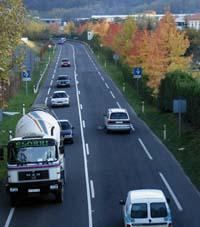From greenhouses to roads

However, the main component of roads is stone, which uses asphalt bitumen in a very small percentage.
To improve the mechanical properties of roads, different polymers are incorporated into asphalt bitumen. These polymers can be both virgin and recycled. The addition of polymer improves, among other things, the response of asphalt bitumen to these temperature changes. Thus, there are no cracks in asphalt at low temperatures, and heavy vehicle traffic does not generate grooves or grooves at high temperatures. However, an adequate mixture of asphalt and polymer bitumen is essential. This mixture should be stable to prevent phase separation of asphalt bitumen and polymer during storage.
Greenhouse plastics
Different polymers can be used to mix with asphalt bitumens, one of them being greenhouse plastics. These greenhouse plastics are recycled and have several applications, including trash bags. However, these polymers cannot be reused for the manufacture of greenhouse plastics, as they lose mechanical properties in their use and recycling.
In this sense, the UPV/EHU research team wants to see if these polymers can be used for road asphalt. For this purpose, asphalt commercial bitumen has been mechanically mixed with recycled polymer by a helix. All this at high temperatures, that is, with both melted materials. If the polymer is compatible with asphalt bitumen, it is spread into small homogeneous drops in the asphalt filler, allowing this mixture to have better viscoelastic properties than the original asphalt bitumen. In fact, researchers have discovered that the polymer is spread in small drops and homogeneously in asphalt bitumen, with the help of the optical microscope.

Therefore, researchers at the UPV/EHU consider that greenhouse plastics are suitable for road asphalt. In fact, researchers have found that these plastics generally contain polymers that mix with asphalt bitumen. In addition, the main advantage of these plastics is that it is not necessary to clean them to mix them with asphalt bitumen and apply them on roads. That is, even if they are remains of land, they work the same.
On the other hand, the mixture of asphalt bitumen and greenhouse plastic presents mechanical and viscoelastic properties similar to those of some virgin polymers. That is, the final product is not affected by the use of a recycled polymer in its production.
All this has been carried out by UPV researchers. Later it should be extended to the industrial scale. To do this, these mixtures must meet the requirements established by road regulations. However, if the roads can be used for asphalt, a lot of tons of plastic will be solved. 800 kg of polymer per kilometer of road. Then take the bills.






